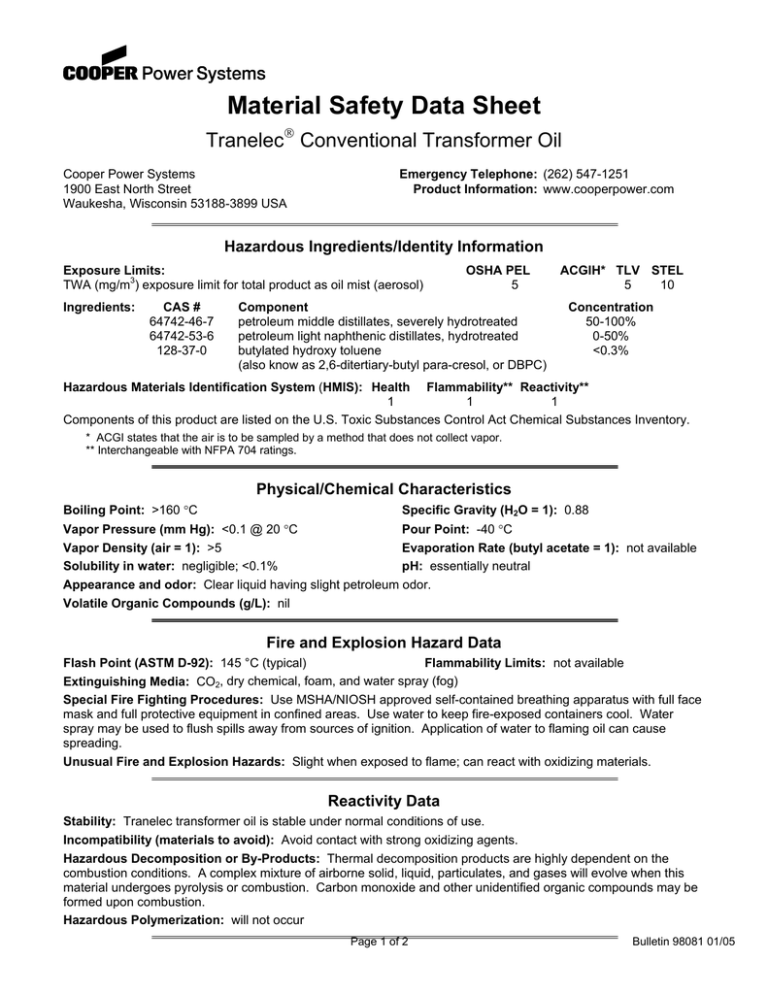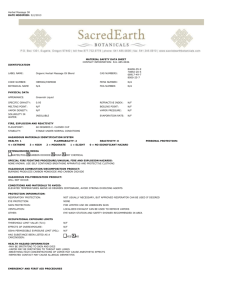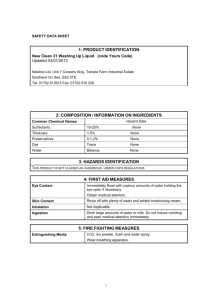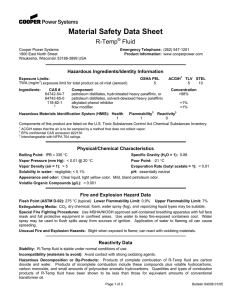Material Safety Data Sheet Tranelec Conventional Transformer Oil
advertisement

Material Safety Data Sheet Tranelec Conventional Transformer Oil Cooper Power Systems 1900 East North Street Waukesha, Wisconsin 53188-3899 USA Emergency Telephone: (262) 547-1251 Product Information: www.cooperpower.com Hazardous Ingredients/Identity Information Exposure Limits: TWA (mg/m3) exposure limit for total product as oil mist (aerosol) Ingredients: CAS # 64742-46-7 64742-53-6 128-37-0 OSHA PEL 5 Component petroleum middle distillates, severely hydrotreated petroleum light naphthenic distillates, hydrotreated butylated hydroxy toluene (also know as 2,6-ditertiary-butyl para-cresol, or DBPC) ACGIH* TLV STEL 5 10 Concentration 50-100% 0-50% <0.3% Hazardous Materials Identification System (HMIS): Health Flammability** Reactivity** 1 1 1 Components of this product are listed on the U.S. Toxic Substances Control Act Chemical Substances Inventory. * ACGI states that the air is to be sampled by a method that does not collect vapor. ** Interchangeable with NFPA 704 ratings. Physical/Chemical Characteristics Boiling Point: >160 °C Specific Gravity (H2O = 1): 0.88 Vapor Pressure (mm Hg): <0.1 @ 20 °C Pour Point: -40 °C Vapor Density (air = 1): >5 Evaporation Rate (butyl acetate = 1): not available Solubility in water: negligible; <0.1% pH: essentially neutral Appearance and odor: Clear liquid having slight petroleum odor. Volatile Organic Compounds (g/L): nil Fire and Explosion Hazard Data Flash Point (ASTM D-92): 145 °C (typical) Flammability Limits: not available Extinguishing Media: CO2, dry chemical, foam, and water spray (fog) Special Fire Fighting Procedures: Use MSHA/NIOSH approved self-contained breathing apparatus with full face mask and full protective equipment in confined areas. Use water to keep fire-exposed containers cool. Water spray may be used to flush spills away from sources of ignition. Application of water to flaming oil can cause spreading. Unusual Fire and Explosion Hazards: Slight when exposed to flame; can react with oxidizing materials. Reactivity Data Stability: Tranelec transformer oil is stable under normal conditions of use. Incompatibility (materials to avoid): Avoid contact with strong oxidizing agents. Hazardous Decomposition or By-Products: Thermal decomposition products are highly dependent on the combustion conditions. A complex mixture of airborne solid, liquid, particulates, and gases will evolve when this material undergoes pyrolysis or combustion. Carbon monoxide and other unidentified organic compounds may be formed upon combustion. Hazardous Polymerization: will not occur Page 1 of 2 Bulletin 98081 01/05 Health Hazard Data Routes of Entry: Skin contact; eye contact or inhalation possible under mist conditions. Skin: Essentially non-toxic. Rabbit acute dermal LD50 >2000 mg/kg. Repeated or prolonged contact may result in localized irritation of the skin. May cause allergic reactions in some individuals. Ingestion: Essentially non-toxic. Rat acute oral LD50 >5000 mg/kg. May cause gastrointestinal distress. Symptoms may include irritation, nausea, vomiting and diarrhea. Inhalation: May cause respiratory tract irritation. Exposure to dense oil mist may lead to respiratory problems. NTP: no IARC Monographs: no OSHA Regulated: no Carcinogenicity: none Signs and Symptoms of Exposure: Prolonged or repeated skin contact may cause irritation. Medical Conditions Generally Aggravated by Exposure: none recognized Emergency and First Aid Procedures: If ingested, DO NOT induce vomiting. If spontaneous vomiting occurs, monitor the subject for breathing difficulty. Get immediate medical attention. If inhaled, remove affected person from exposure to mists. For eye contact, flush the eyes immediately with large amounts of water with the eyelids held away from the eye to ensure thorough rinsing. For skin contact, remove by washing with soap and water. Get medical attention if irritation persists. Control Measures Respiratory Protection: Use MSHA/NIOSH approved supplied-air respiratory protection if occupational exposure limits are exceeded. Ventilation: Use local exhaust to capture vapor, mists, or fumes if necessary. Protective Gloves: Use chemical-resistant (nitrile) gloves to prevent prolonged or repeated skin contact. Eye Protection: Wear splash goggles or safety shield to prevent eye contact. Eye baths should be readily available in the area of handling Tranelec oil. Other Protective Clothing or Equipment: Wear chemical-resistant (nitrile) apron or other impervious clothing to avoid prolonged or repeated skin contact. Work/Hygenic Practices: Wash with soap and water after contact. Avoid exposure to mists. Precautions for Safe Handling and Use Steps to be Taken in Case Material is Released or Spilled: Stop flow or eliminate source of leakage. Eliminate all sources of ignition. Absorb with an oil absorbent material. No special hazards except under mist or spray conditions. A spill or release to navigable waters must be reported immediately to the National Response Center (800-4248802). Spills may be reportable to state or local agencies. Waste Disposal: For recycling, consult with local used oil recyclers. Tranelec oil when recycled, discarded or disposed of is a used oil per 40 CFR 279. Tranelec oil is not a hazardous waste per 40 CFR 261. Tranelec oil from retrofilled electrical equipment, by virtue of contamination from residues of earlier fluid(s), may qualify as a hazardous waste per 40 CFR 261. Precautions to be Taken in Handling and Storage: Avoid extremes of temperature in storage. Store Tranelec oil in labeled, tightly closed containers in cool, dry, isolated and well ventilated areas, away from sources of ignition or heat. To maintain fluid for intended use as an electrical insulating fluid, eliminate exposure to oxygen and moisture. This Material Safety Data Sheet has been prepared in order to help the users of Tranelec conventional transformer oil. The data contained herein is accurate as of the date of preparation of this sheet. Effective Date: January 13, 2005 John Luksich Senior Engineer – Dielectric Fluids Page 2 of 2 Bulletin 98081 01/05









